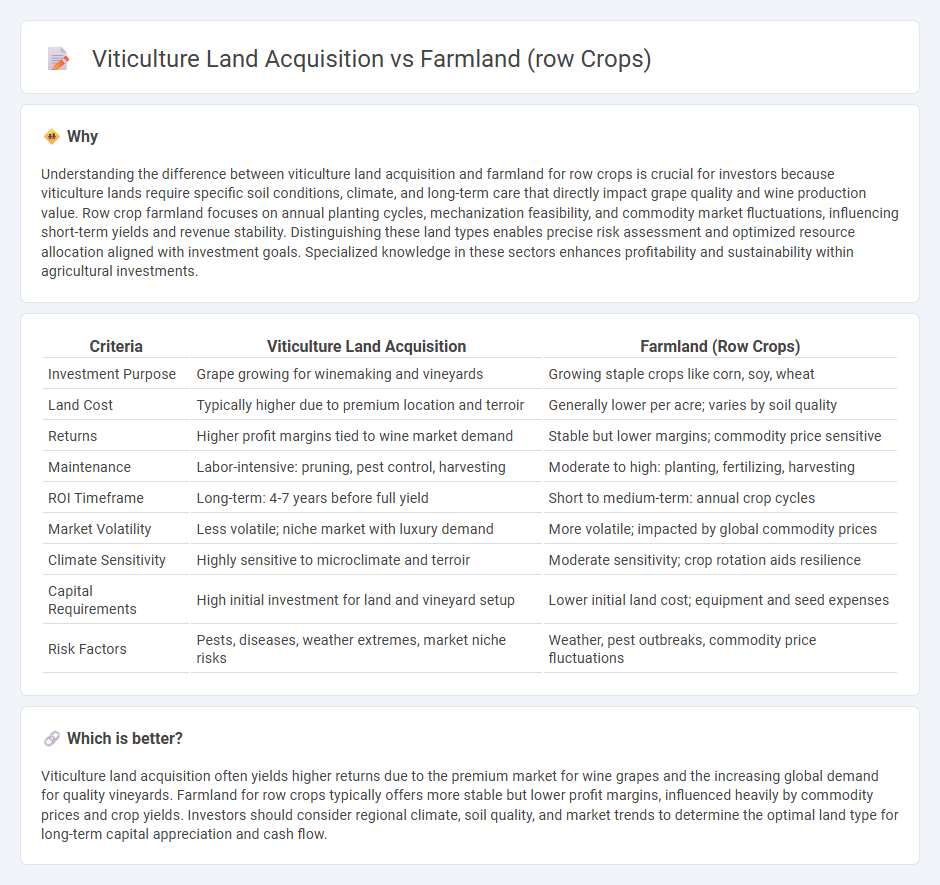
Viticulture land acquisition offers investors the potential for high-value grape production with opportunities in wine and specialty markets, while farmland dedicated to row crops typically ensures consistent yields with broader commodity demand and diversified crop options. Grapevine cultivation demands specific climate and soil conditions, which can enhance land value but also requires specialized management compared to the relatively flexible agronomy of row crops like corn or soybeans. Explore the benefits and risks of each to determine the best fit for your agricultural investment strategy.
Why it is important
Understanding the difference between viticulture land acquisition and farmland for row crops is crucial for investors because viticulture lands require specific soil conditions, climate, and long-term care that directly impact grape quality and wine production value. Row crop farmland focuses on annual planting cycles, mechanization feasibility, and commodity market fluctuations, influencing short-term yields and revenue stability. Distinguishing these land types enables precise risk assessment and optimized resource allocation aligned with investment goals. Specialized knowledge in these sectors enhances profitability and sustainability within agricultural investments.
Comparison Table
| Criteria | Viticulture Land Acquisition | Farmland (Row Crops) |
|---|---|---|
| Investment Purpose | Grape growing for winemaking and vineyards | Growing staple crops like corn, soy, wheat |
| Land Cost | Typically higher due to premium location and terroir | Generally lower per acre; varies by soil quality |
| Returns | Higher profit margins tied to wine market demand | Stable but lower margins; commodity price sensitive |
| Maintenance | Labor-intensive: pruning, pest control, harvesting | Moderate to high: planting, fertilizing, harvesting |
| ROI Timeframe | Long-term: 4-7 years before full yield | Short to medium-term: annual crop cycles |
| Market Volatility | Less volatile; niche market with luxury demand | More volatile; impacted by global commodity prices |
| Climate Sensitivity | Highly sensitive to microclimate and terroir | Moderate sensitivity; crop rotation aids resilience |
| Capital Requirements | High initial investment for land and vineyard setup | Lower initial land cost; equipment and seed expenses |
| Risk Factors | Pests, diseases, weather extremes, market niche risks | Weather, pest outbreaks, commodity price fluctuations |
Which is better?
Viticulture land acquisition often yields higher returns due to the premium market for wine grapes and the increasing global demand for quality vineyards. Farmland for row crops typically offers more stable but lower profit margins, influenced heavily by commodity prices and crop yields. Investors should consider regional climate, soil quality, and market trends to determine the optimal land type for long-term capital appreciation and cash flow.
Connection
Investment in viticulture land acquisition and farmland for row crops both represent strategic assets within the agricultural sector, offering opportunities for diversification and long-term capital appreciation. Viticulture land, valued for its suitability to grape cultivation, often commands premium prices due to its specialized soil and climate conditions, while row crop farmland, essential for staple crops like corn and soybeans, provides consistent revenue streams through commodity production. The connection lies in their complementary roles in agribusiness investment portfolios, balancing high-value specialty crop potential with broad-scale row crop production stability.
Key Terms
Crop Yield Potential
Row crop farmland typically offers higher yield potential per acre due to mechanized planting and harvesting techniques optimized for staple grains such as corn and soybeans. Viticulture land, while yielding lower tonnage, often produces high-value grapes essential for premium wine production, emphasizing quality over quantity. Explore further to understand the economic trade-offs and long-term benefits of each agricultural investment.
Water Rights/Access
Water rights are crucial in farmland acquisition, especially for row crops that require extensive irrigation, whereas viticulture land often benefits from more moderate water needs but demands consistent access to high-quality water sources. Securing legal water access through surface or groundwater rights significantly affects the land's productivity and long-term value. Explore how water rights influence these agricultural investments to make informed land acquisition decisions.
Land Zoning Regulations
Land zoning regulations distinctly impact the acquisition of farmland for row crops versus viticulture, with agricultural zoning often favoring crop cultivation through specific soil quality and water access criteria. Viticulture land acquisition faces stricter zoning due to requirements for slope, sunlight, and microclimate conditions, frequently involving specialized agricultural or conservation designations. Explore detailed zoning policies and their implications for strategic land acquisition decisions in agriculture.
Source and External Links
Row crop - Row crops are planted in wide enough rows for machinery cultivation and include crops like sunflower, potato, canola, cotton, maize, soybeans, and sugar beets; they are usually drilled or transplanted rather than broadcast and support crop rotation to maintain soil quality and productivity.
Row Crops & Permanent Crops: What To Keep In Mind As An Investor - Row crops are mostly annual plants such as corn, wheat, barley, rice, soybeans, and cotton, grown yearly with mechanical planting and harvesting, allowing crop rotation for soil health and flexibility in farm management.
Expert Recommendations for Buying Row Crop Farmland - Row crop farming involves growing crops in rows to facilitate machinery access and optimal plant density, with the Midwest US states like Iowa and Nebraska being prime regions for row crops such as corn and soybeans, often rotated to maintain soil nutrients.
 dowidth.com
dowidth.com